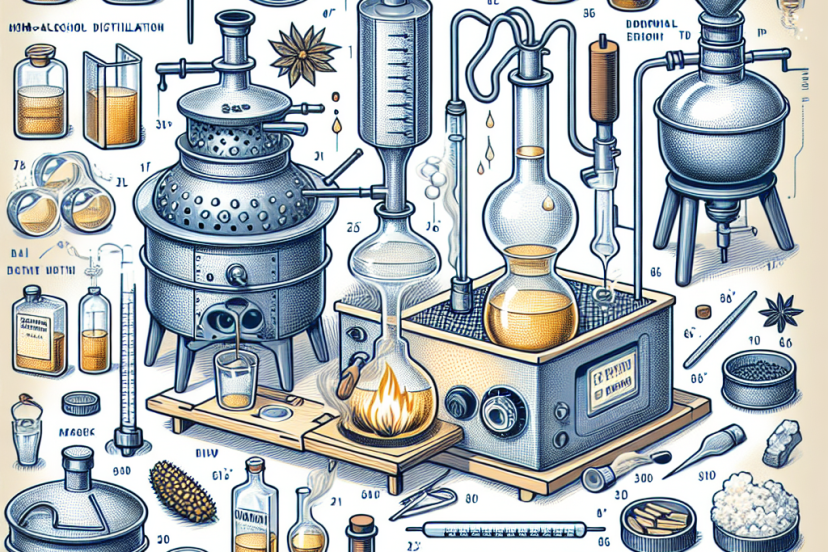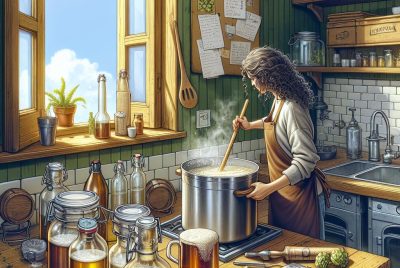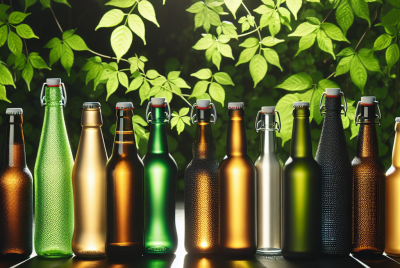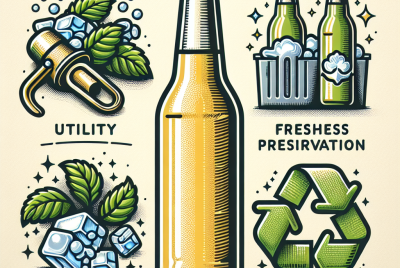Can You Distill Alcohol at Home?
So, you’ve always been curious about the art of distilling, and specifically how to distill alcohol at home, haven’t you? Well, the good news is that it’s entirely possible to embark on this fascinating journey right from the comfort of your own kitchen. While it may sound like a complex task reserved for professionals, home distillation can be an engaging and rewarding experience for any enthusiastic amateur. Not only does it offer the opportunity to create unique and flavorful spirits, but it also allows you to gain a deeper understanding of the intriguing science behind the process. But before you delve into this captivating world, let’s explore the legality, safety, and necessary equipment associated with distilling liquor at home.

Understanding Distillation
Distillation is a process that is often associated with the production of alcohol, but it is actually much more than that. It is a method used to separate and purify liquids based on their different boiling points. While it may sound complex, understanding the basics of distillation can open up a whole world of possibilities for making your own alcohol and even essential oils.
What is distillation?
Distillation is a process that involves heating a liquid to create vapor, and then cooling the vapor to result in a purified liquid. This method takes advantage of the fact that different substances have different boiling points. By heating a mixture to a specific temperature, the components with lower boiling points will vaporize first, while those with higher boiling points will remain in their liquid state. The vapor is then collected and cooled, causing it to condense back into a liquid, resulting in a purified product.
How does distillation work?
Distillation works by utilizing the principle of boiling points. When a mixture is heated, the substance with the lowest boiling point will vaporize first. This vapor is then captured and cooled, causing it to condense back into a liquid form. The process is repeated multiple times to further separate and purify the desired component. By controlling the temperature and the apparatus used, certain impurities can be removed, resulting in a higher quality and more refined end product.
Is distillation legal?
The legality of distillation varies depending on the country and even within different regions. In some places, home distillation is strictly prohibited, while in others, it may be permissible for personal use. It is crucial to research and understand the laws and regulations in your specific location before engaging in any distillation activities. It is important to note that even if home distillation is legal, there may still be restrictions on the types of alcohol that can be produced.
Potential risks and safety concerns
Distillation involves the use of heat and potentially flammable liquids, so it is essential to prioritize safety throughout the process. Proper ventilation is crucial to prevent the buildup of flammable vapors. Additionally, fire safety precautions should be taken, such as having a fire extinguisher nearby and avoiding open flames. Contamination is another concern, so ensuring a clean environment and proper sanitation practices is vital. Monitoring the temperature and pressure during distillation is also important to prevent accidents.
Equipment and Set-up
Essential equipment to distill alcohol at home
To start with home distillation, there are some essential pieces of equipment you will need. These include a still, a heat source, a collection vessel, a condenser, and various tubes and connectors. The still is the main apparatus used for distillation and comes in different types, such as pot stills, reflux stills, and column stills. The heat source can be a stovetop, a gas burner, or an electric heating element, depending on the type of still being used. The collection vessel is where the distilled liquid will be collected, and the condenser is responsible for cooling the vapor back into a liquid form.
Choosing the right still
Choosing the right type of still for your distillation needs is crucial. Pot stills are a popular choice for beginners as they are relatively simple and versatile. Reflux stills, on the other hand, are more complex and are known for producing high-quality spirits. Column stills are often used by commercial distilleries and are capable of producing large quantities of alcohol. Consider your goals and level of experience when selecting a still.
Setting up your distillation apparatus
Setting up your distillation apparatus correctly is essential to ensure a successful and safe distillation process. Start by assembling the still according to the manufacturer’s instructions. Ensure all connections are tight and secure to prevent leaks. Place the still on a stable surface and position the condenser correctly, ensuring it is attached properly. Double-check that the collection vessel is in place and ready to receive the distilled liquid. Once everything is set up, connect the heat source and conduct a trial run without any liquid to check for any issues or leaks.
Legal Considerations
Laws and regulations around home distillation
Before embarking on your home distillation journey, it is crucial to familiarize yourself with the laws and regulations surrounding distillation in your area. While some regions may allow home distillation for personal use, others strictly prohibit the practice. It is important to research and understand the specific restrictions and requirements, such as quantity limits, labeling regulations, and record-keeping obligations. Staying informed and compliant will ensure you can enjoy your homemade spirits without any legal complications.
Permits and licenses
In some jurisdictions where home distillation is legal, obtaining permits or licenses may be necessary. These permits often involve inspections, fees, and compliance with specific regulations. It is essential to check with your local authorities to determine which permits or licenses are required, and to ensure that you meet all the necessary criteria. Applying for and obtaining the appropriate permits will provide you with peace of mind and legal protection when engaging in home distillation.
Restrictions on the types of alcohol
Even in places where home distillation is legal, there may be restrictions on the types of alcohol that can be produced. Some jurisdictions prohibit the production of high-proof spirits, moonshine, or certain types of liquors. Understanding these restrictions will help you choose the right base material and ensure that your distillation activities comply with the law. Always verify the specific regulations in your area to avoid any legal issues.
Source of Alcohol
Selecting the base material
The base material, or the starting point for distillation, plays a crucial role in the final product. Depending on the type of alcohol you wish to distill, the base material can vary. For spirits like whiskey or vodka, grains such as barley or corn are commonly used. Fruits, such as grapes or apples, are often chosen for making brandy or fruit-based spirits. Sugars, such as molasses or cane sugar, are popular for producing rum. Consider the flavor profile and characteristics you desire in your final product when selecting the base material.
Fermentation process
Before distillation can occur, the base material needs to undergo fermentation. Fermentation is a natural process where the sugars in the base material are converted into alcohol by yeast or other microorganisms. Depending on the specific recipe and desired alcohol, the fermentation process can take a few days to several weeks. It is important to follow proper fermentation techniques, including maintaining the correct temperature, monitoring the yeast activity, and ensuring an oxygen-free environment. Patience and attention to detail during fermentation will contribute to a successful distillation.
Using store-bought alcohol
If you are new to distillation or prefer not to go through the fermentation process, another option is to distill store-bought alcohol. There are certain legal considerations and restrictions when it comes to this method, as the quality and composition of the store-bought alcohol can affect the final product. However, using high-quality spirits as your base material can still allow you to experiment with the distillation process and customize your spirits to your liking.
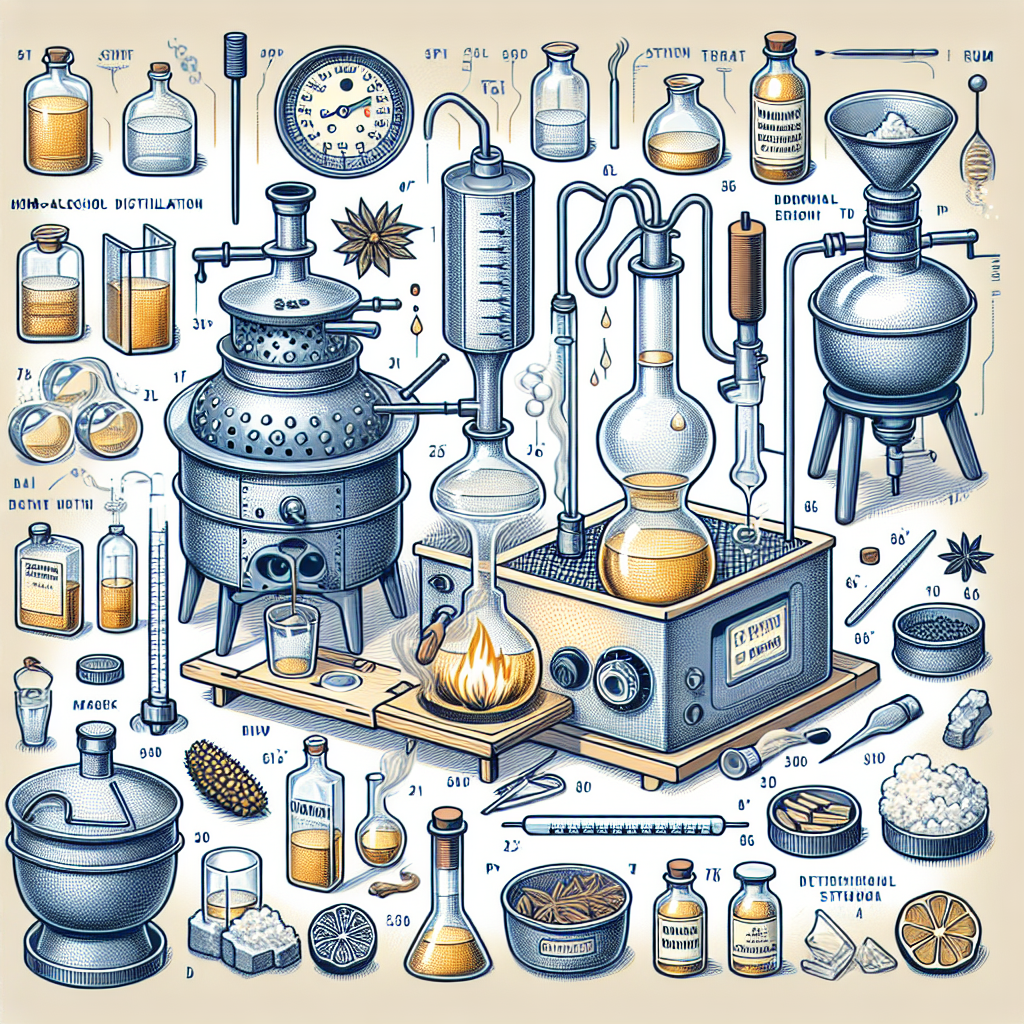
The Distillation Process
Preparing the wash for distillation
Once fermentation is complete, the next step is to prepare the wash for distillation. The wash refers to the liquid that contains the fermented base material and is ready to be distilled. Depending on the recipe and desired alcohol, the wash may need to undergo additional processing or filtration before entering the still. This step helps remove any unwanted solids or impurities that could affect the distillation process or result in an inferior final product.
Heating and vaporization
With the wash prepared, it is time to begin the distillation process. The wash is added to the still, and heat is applied to raise the temperature. As the temperature increases, the alcohol vaporizes and rises into the still’s neck, leaving behind the water, impurities, and other unwanted substances. The vapor then travels through the condenser, where it is cooled and returns to its liquid form.
Condensing and collecting the alcohol
The condenser plays a crucial role in collecting and cooling the alcohol vapor. It is designed to facilitate the conversion of the vapor back into a liquid state. As the vapor passes through the condenser, cold water or another cooling medium is circulated around it, causing it to lose heat and condense into liquid alcohol. The condensed alcohol is then collected in the collection vessel, ready to be enjoyed or further processed.
Types of Alcohol You Can Distill
Distilling spirits
Spirits, such as whisky, rum, and brandy, are among the most popular types of alcohol that can be distilled at home. Each spirit has its unique flavors and production methods, giving you the opportunity to experiment and create your own custom versions. Distilling spirits often involves aging the distilled alcohol in barrels or adding flavorings to achieve the desired taste and complexity.
Distilling whiskey
Whiskey is a beloved spirit that enthusiasts often enjoy experimenting with at home. The distillation process for whiskey usually involves using grains, such as barley or corn, as the base material. The wash is then fermented and distilled, followed by aging the spirit in oak barrels. The aging process contributes to the development of flavors and complexity, giving each whiskey its distinctive characteristics.
Distilling vodka
Vodka is a versatile spirit that is often a favorite choice for home distillers. It can be made from various base materials, including grains, potatoes, or even fruits. The distillation process for vodka focuses on achieving a clean and neutral-tasting spirit. The final product is typically filtered to remove any impurities, resulting in a smooth and pure vodka.
Distilling moonshine
Moonshine is often associated with homemade alcohol, and the term refers to unaged and illegally produced spirits. While the production of moonshine may not be legal in your area, understanding the distillation process behind it can still be fascinating. The base material for moonshine can vary, including corn, sugar, or fruit. The distilled alcohol is typically enjoyed without aging, resulting in a potent and robust spirit.
Distilling essential oils
Apart from alcoholic beverages, distillation can also be used to extract essential oils from plants. This process is known as steam distillation and involves heating the plant material to release the essential oils, which are then collected and cooled. Steam distillation allows for the extraction of aromatic compounds from various plants, including lavender, rosemary, or eucalyptus. These essential oils can be used in aromatherapy, skincare products, or for flavoring foods and beverages.
Quality and Flavor
Understanding the importance of cuts
When distilling alcohol, making cuts refers to the process of separating the different fractions that are collected during distillation. These fractions include the “heads,” “hearts,” and “tails.” The “heads” contain volatile compounds that can give off unpleasant flavors or aromas, such as methanol. The “hearts” are the desired portion and contain the purest and most flavorful alcohol. The “tails” contain heavier compounds that can result in undesirable flavors. Properly making and separating cuts is essential to producing a high-quality and flavorful spirit.
Removing impurities
Distillation is an effective method for removing impurities from the final product. During the distillation process, impurities, such as flavors, colors, and unwanted substances, are left behind in the still, while the pure alcohol is collected. However, it is essential to note that not all impurities may be eliminated through distillation alone. Additional filtration or purification methods, such as carbon filtering or re-distillation, may be necessary to achieve the desired level of purity.
Enhancing or altering flavors
Distillation not only removes impurities but also allows for the enhancement or alteration of flavors. Through the selection of the base material, fermentation process, and the use of different botanicals or flavorings, you can customize the taste profile of your distilled spirits. Experimenting with different ingredients, aging techniques, or even blending spirits can result in unique and interesting flavors that suit your preferences.
Safety Tips for Home Distillation
Proper ventilation
Proper ventilation is crucial during the distillation process to prevent the buildup of flammable vapors. Distillation should be conducted in a well-ventilated area, preferably with a fan or extractor to remove any potentially hazardous fumes. Good airflow will help minimize the risk of explosions or accidents caused by the accumulation of flammable vapors in an enclosed space.
Fire safety precautions
Given that distillation involves heat and flammable liquids, it is essential to take fire safety precautions. Ensure you have a fire extinguisher nearby and easily accessible in case of emergencies. Avoid using open flames or smoking during the distillation process. It is also recommended to have a fire-resistant surface underneath the distillation apparatus to protect against accidental spills or splashes.
Avoiding contamination
Contamination can greatly affect the quality and safety of the distilled alcohol. Ensure that all equipment, containers, and utensils used during the distillation process are properly cleaned and sanitized. It is also advisable to use food-grade materials and avoid any substances that could introduce unwanted flavors or compounds. A sterile environment and good hygiene practices will help prevent contamination and ensure the production of a safe and high-quality product.
Monitoring temperature and pressure
Temperature and pressure control during distillation are critical for safety and proper results. It is important to monitor the temperature closely and adjust the heat source accordingly to maintain the desired temperature range. Incorrect temperature or pressure can lead to inefficient distillation or even equipment failure. Utilize a reliable thermometer and pressure gauge to ensure you stay within the optimal operating conditions.
Alternatives to Distillation
Infusing spirits with flavors
If you are not ready to dive into full-fledged distillation, a great alternative is to infuse spirits with flavors. This method involves adding herbs, fruits, spices, or other flavorings to an already distilled spirit. The spirit absorbs the flavors over time, resulting in unique and flavorful concoctions. Infused spirits can be enjoyed on their own or used as the base for various cocktails and mixed drinks.
Making homemade liqueurs
Homemade liqueurs allow you to indulge in the creation of sweet and flavorful alcoholic beverages. Liqueurs are created by infusing fruits, spices, or herbs into a base alcohol, such as vodka or brandy. The resulting mixture is sweetened with sugar or syrup to create a balanced and delectable liqueur. Crafting your own homemade liqueurs allows you to experiment with different flavor combinations and create personalized drinks that can be enjoyed on their own or used in cocktails and desserts.
Blending commercial alcohols
Blending commercial alcohols is another alternative to distillation that allows you to create unique flavors and profiles. By combining different spirits, such as whiskey, vodka, or rum, you can create your own blends tailored to your taste preferences. Blending allows you to experiment and fine-tune the flavors of your spirits without the need for distillation equipment. This method provides an opportunity to craft your own signature concoctions using readily available commercial spirits.
Conclusion
Understanding the process of distillation opens up a world of possibilities for creating your own alcoholic beverages and even essential oils at home. From selecting the right equipment to abiding by legal regulations, there are various factors to consider when embarking on your distillation journey. By following safety precautions, paying attention to quality and flavor, and considering alternative methods, you can enjoy the art and science of distillation while producing high-quality and personalized spirits. So, why not give it a try and embark on your own home distillation adventure? Cheers to your creativity and enjoyment in the world of distillation!

